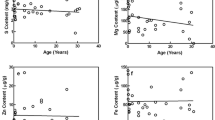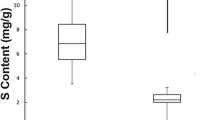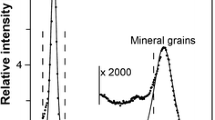Abstract
To elucidate compositional changes of ligaments with aging, the authors investigated age-related changes of elements in the posterior longitudinal ligaments (PLLs) by inductively coupled plasma—atomic emission spectrometry. After the ordinary dissection, PLLs were resected from the subjects ranging in age from 65 to 95 yr. The PLLs of the cervical spine were resected between the fourth and fifth cervical vertebrae, the PLLs of the thoracic spine between the fifth and seventh thoracic vertebrae, and the PLLs of the lumbar spine between the second and third lumbar vertebrae. Calcium and magnesium increased progressively with aging in the PLLs of the cervical spine, but they did not increase with aging in the PLLs of the thoracic and lumbar spine. In contrast, iron decreased gradually with aging in the PLLs of the cervical spine. Regarding the relationships among elements, significant correlations were found among the contents of calcium, phosphorus, magnesium, and sodium in the PLLs of the cervical spine.
Similar content being viewed by others
References
L. Agostini, E. Ciorba, N. Caputo, et al., Myelopathic patterns of calcification of the posterior longitudinal ligament, Riv. Patol. Nerv. Ment. 100, 201–208 (1979).
H. Firooznia, V. M. Benjamin R. S. Pinto, et al., Calcification and ossification of posterior longitudinal ligament of spine: its role in secondary narrowing of spinal canal and cord compression, NY State J. Med. 82, 1193–1198 (1982).
H. Firooznia, M. Rafii, C. Golimbu, et al., Computed tomography of calcification and ossification of posterior longitudinal ligament of the spine, J. Comput. Tomogr. 8, 317–324 (1984).
M. Hanna and I. Watt, Posterior longitudinal ligament calcification of the cervical spine, Br. J. Radiol. 52, 901–905 (1979).
Y. Hashizume, Pathological studies on the ossification of the posterior longitudinal ligament (opll), Acta Pathol. Jpn. 30, 255–273 (1980).
G. R. Harsh, 4th, G. W. Sypert, P. R. Weinstein, et al., Cervical spine stenosis secondary to ossification of the posterior longitudinal ligament, J. Neurosurg. 67, 349–357 (1987).
Y. Hiramatsu and T. Nobechi, Calcification of the posterior longitudinal ligament of the spine among Japanese, Radiology 100, 307–312 (1971).
K. Izawa, Comparative roentgenographical study on the incidence of ossification of the posterior longitudinal ligament and other degenerative changes of the cervical spine among Japanese, Koreans, Americans and Germans, Nippon Seikeigeka Gakkai Zasshi 54, 461–474 (1980).
A. Kurata, K. Tokiwa, I. Kitahara, et al., Myelopathy caused by hypertrophy of the posterior longitudinal ligament (HPLL): case report, No Shinkei Geka 15, 651–655 (1987).
T. Lee, P. B. Chacha, and J. Khoo, Ossification of posterior longitudinal ligament of the cervical spine in non-Japanese Asians, Surg. Neurol. 35, 40–44 (1991).
H. Minagi and A. T. Gronner, Calcification of the posterior longitudinal ligament: a cause of cervical myelopathy, Am. J. Roentgenol. Radium Ther. Nucl. Med. 105, 365–369 (1969).
K. Ono, K. Yonenobu, S. Miyamoto, et al., Pathology of ossification of the posterior longitudinal ligament and ligamentum flavum, Clin. Orthop. 359, 18–26 (1999).
J. O. Orth, Calcification and ossification of the posterior and longitudinal ligament of the cervical spine, ROFO Fortschr. Geb. Rontgenstr. Nuklearmed. 122, 442–445 (1975).
W. M. Park and K. Mourad, Ossification and calcification of the posterior longitudinal ligament of the spine, Br. J. Radiol. 53, 375–376 (1980).
D. Resnick, J. Guerra, Jr, C. A. Robinson, et al., Association of diffuse idiopathic skeletal hyperostosis (DISH) and calcification and ossification of the posterior longitudinal ligament, Am. J. Roentgenol. 131, 1049–1053 (1978).
Y. S. Soo and A. S. Sachdev, Calcification in the posterior longitudinal ligament as a cause of cervical myelopathy, Med. J. Aust. 1, 743–744 (1971).
K. Terayama, So-called calcification of the posterior longitudinal ligament, Seikei Geka 21, 1013 (1970).
Y. Tohno, S. Tohno, H. Matsumoto, et al., A trial of introducing soft X-ray apparatus into dissection practice for students, J. Nara Med. Assoc. 36, 365–370 (1985).
Y. Tohno, S. Tohno, T. Minami, et al., Age-related changes of mineral contents in the human thoracic aorta and in the cerebral artery, Biol. Trace Element Res. 54, 23–31 (1996).
M. D. Grynpas, K. P. H. Pritzker, and R. G. V. Hancock, Neutron activation analysis of bulk and selected trace elements in bones using a low flux slowpoke reactor, Biol. Trace Element Res. 13, 333–344 (1987).
S. Tohno, Y. Tohno, T. Minami, et al., Elements of calcified sites in human thoracic aorta, Biol. Trace Element Res. 86, 23–30 (2002).
H. Tsukimoto, A case report: autopsy of syndrome of compression of spinal cord owing to ossification within spinal canal of cervical spines, Nihon Geka Hokan 29, 1003–1007 (1960).
H. Seki, N. Tsuyama, K. Hayashi, et al., Ossification of the posterior longitudinal ligament, a clinical analysis of 185 cases, Seikeigeka 25, 704–710 (1974).
R. Yagan, M. A. Khan, and E. M. Bellon, Spondylitis and posterior longitudinal ligament ossification in the cervical spine, Arthritis Rheum. 26, 226–230 (1983).
S. Tohno, Y. Tohno, T. Minami, et al., Difference of mineral contents in human intervertebral disks and its age-related change, Biol. Trace Element Res. 52, 117–124 (1996).
T. Kubota, K. Sato, H. Kawano, et al., Ultrastructure of early calcification in cervical ossification of the posterior longitudinal ligament. J. neurosurg. 61, 131–135 (1984).
Y. Tohno, Y. Moriwake, Y. Takano, et al., Age-related changes of elements in human anterior cruciate ligaments and ligamenta capitum femorum, Biol. Trace Element Res. 68, 181–192 (1999).
Y. Tohno, S. Tohno, Y. Moriwake, et al., Accumulation of calcium and phosphorus accompanied by increase of magnesium and decrease of sulfur in human arteries, Biol. Trace Element Res. 82, 9–19 (2001).
S. Tohno, Y. Tohno, Y. Moriwake, et al., Quantitative changes of calcium, phosphorus, and magnesium in common iliac arteries with aging. Biol. Trace Element Res. 84, 57–66 (2001).
Y. Tohno, S. Tohno, Y. Moriwake, et al., Simultaneous accumulation of calcium, phosphorus, and magnesium in various human arteries. Biol. Trace Element Res. 82, 21–28 (2001).
S. Tohno, Y. Tohno, T. Minami, et al., Relationships among element contents in the internal jugular vein similar to the arteries, Biol. Trace Element Res. 88, 223–233 (2002).
Y. Takano, Y. Moriwake, Y. Tohno, et al., Age-related changes of elements in the human articular disk of the temporomandibular joint, Biol. Trace Element Res. 67, 269–276 (1999).
R. Z. Le Geros, S. R. Contiguglia, and A. C. Alfrey, Pathological calcification associated with uremia, two types of calcium phosphate deposits, Calcif. Tissue Res. 13, 173–185 (1973).
N. C. Blumenthal, F. Betts, and A. S. Posner, Stabilization of amorphous calcium phosphate by Mg and ATP, Calcif. Tissue Res. 13, 173–185 (1977).
Author information
Authors and Affiliations
Rights and permissions
About this article
Cite this article
Utsumi, M., Azuma, C., Tohno, S. et al. Increases of calcium and magnesium and decrease of iron in human posterior longitudinal ligaments of the cervical spine with aging. Biol Trace Elem Res 103, 217–227 (2005). https://doi.org/10.1385/BTER:103:3:217
Received:
Accepted:
Issue Date:
DOI: https://doi.org/10.1385/BTER:103:3:217




